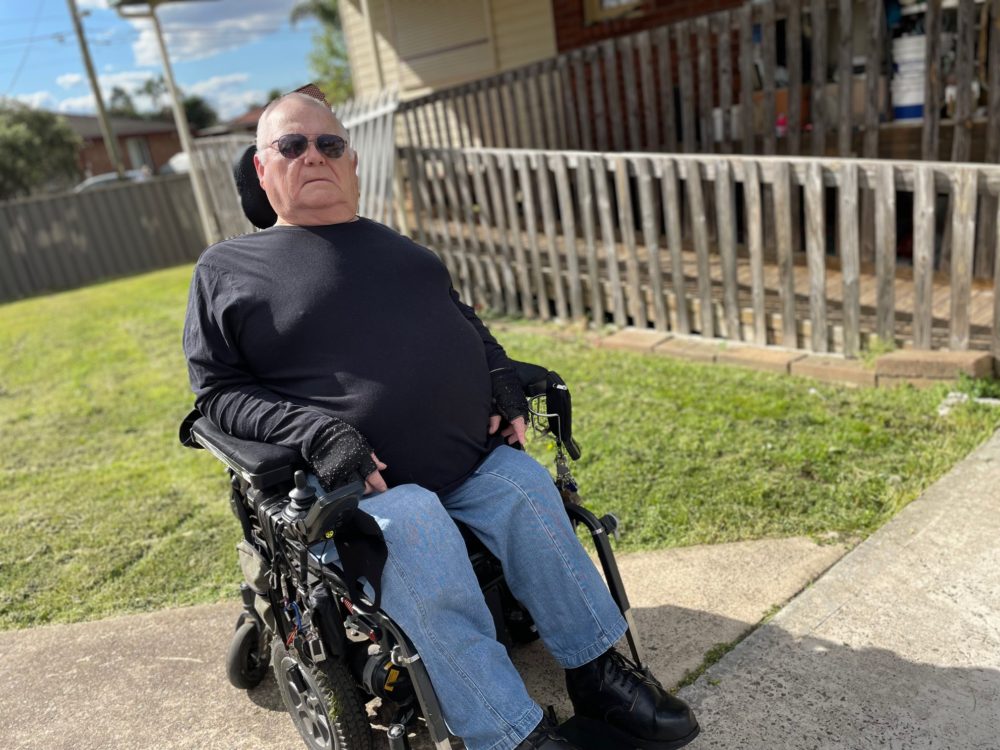By Neena Bhandari
Sydney, 20.10.2021 (Hireup): George Laszuk is among thousands of Australians with a disability who are not covered by the National Disability Insurance Scheme (NDIS), which excludes people over the age of 65.
He missed the NDIS safety net by less than a year. “It came as a bombshell. I felt cheated. We had campaigned for it for so many years. Until today, it has never been made clear as to why we were excluded,” says Laszuk, who contracted poliomyelitis at 11 months of age in 1951. October is polio awareness month.
He is now experiencing Post-Polio Syndrome and requires a powered wheelchair and assistance with showering and daily chores. His My Aged Care package barely meets his daily needs despite him being in the highest category of the program.
“To maintain my independence, I need a new wheelchair. I also need to modify my bathroom to be accessible. The program has no real funding for ‘assistive technology’,” the 71-year-old says.
The NDIS would have picked up the tab if he was under the age of 65, when the scheme began rolling out across the country from July 1, 2016.
“I am hoping that by cutting down on showers to alternate days and not engaging a support worker on weekends [penalty rates apply on weekends], I will someday be able to save enough funds in My Aged Care package to pay for these necessary supports,” adds Laszuk, who works part-time as office co-ordinator of Polio NSW.
Senator and Australian Greens disability rights advocate Jordon Steele-John has heard from many disabled people that My Aged Care doesn’t provide them with the level of support they need. “The NDIS should be available to disabled people when and where they need it,” he says.
So, what was the reasoning behind excluding older Australians?
People with Disability Australia’s (PWDA) senior policy officer, Samantha French says: “We were told that 65 years was when people would be eligible for Centrelink’s Aged Care Pension and a suite of other financial supports for older Australians, including My Aged Care.
“We had argued there should be no age limit on adults accessing the NDIS back when it was being designed, and we still believe there should be no age limit.”
Graeme Innes, board member of Life Without Barriers and former disability discrimination commissioner, says: “The logic of this was dollars. The correlation between ageing and disability including people over the age of 65 would have made the scheme unsustainable.
“However, there is a significant unmet need here, and the best way to resolve it would be through the My Aged Care funding.”
Bill Shorten was a key architect of the NDIS as the then parliamentary secretary for disabilities and children’s services. Now federal Opposition spokesman for the NDIS and government services, he says: “When the NDIS was created in 2013, it was designed for those aged 65 and younger, to complement aged care for over-65s, and ensure a cohesive safety net to give people with disability of all ages and their families and carers the support they need.
“The NDIS – even though it has its problems – is now superior when compared with aged care packages.
“People with disability may require additional support and care as they age, and it is important the aged-care system is responsive to the needs of all older Australians. Labor believes people should get the care they need, no matter how old they are.”
Also excluded from the NDIS are people who become disabled after they turn 65.
Australian Television presenter, Kerri-Anne Kennerley’s late husband became paralysed from his neck down after a fall in 2016 and required 24/7 care. But because he became disabled over the age of 65, he was put under the My Aged Care program. Kennerley is now considering legal action against the government because she claims the NDIS “discriminates” against people aged over 65.
According to a spokesperson for Linda Reynolds, minister for the NDIS, “When established, the NDIS was designed to avoid replacing services already provided through the health or aged care systems.”
“The design of the NDIS reflects the Productivity Commission’s recommendation, that a person needs to have acquired their disability and requested access to the scheme before the age of 65, to become an NDIS participant. The legislation put forward by the Gillard Government in 2012 to establish the NDIS, with bipartisan support, reflects this recommendation and is a longstanding policy.”
In 2018, out of 4.4 million people with a disability, 1.9 million were aged 65 years and over. They are funded through the federal government’s My Aged Care program. However, people who started receiving NDIS support before turning 65 are eligible to continue receiving NDIS funds for the rest of their lives , or choose the aged care system once they reach age 65.
© Copyright Neena Bhandari. All rights reserved. Republication, copying or using information from neenabhandari.com content is expressly prohibited without the permission of the writer and the media outlet syndicating or publishing the article.


